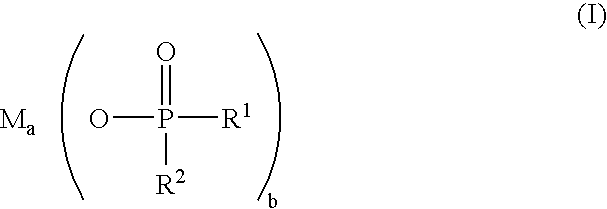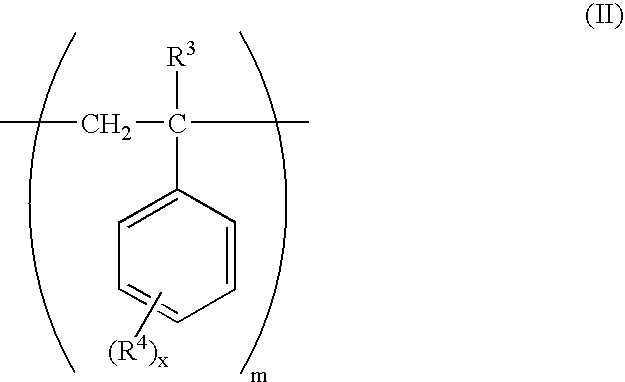Thermosetting resin composition and prepreg and laminated sheet using the same
- Summary
- Abstract
- Description
- Claims
- Application Information
AI Technical Summary
Benefits of technology
Problems solved by technology
Method used
Image
Examples
synthesis example 1
Component (3): Preparation of Cyanate Ester Resin (3-1)
[0093] Into a 3 L-volume reactor equipped with a thermometer, a stirrer, and a condenser tube and being capable of heating and cooling were charged 1,519 g of 2,2-di(cyanatophenyl)propane, 23.1 g of para-cumylphenol, and 1,022 g of toluene. The mixture was heated to 80° C., and 0.22 g of an 8% by weight solution of zinc naphthenate was added thereto while maintaining the temperature at 77 to 83° C. After completion of the addition of the solution, a reaction was performed at 80° C. for 3.5 hours to obtain cyanate ester resin solution (3-1). The solid content of the solution (3-1) was 61% by weight, and a measurement using gel permeation chromatography confirmed that 45% by mol of 2,2-di(cyanatophenyl)propane as the raw material formed a trimer and / or a larger polymer by self-polymerization.
synthesis example 2
Components (2-1) and (3): (A-1) Preparation of Semi-IPN (Interpenetrating Polymer Network) Structure Between a Copolymer Resin Comprising Styrene and Maleic Anhydride, and a Cyanate Ester Resin
[0094] Into a 5 L-volume reactor equipped with a thermometer, a stirrer, and a condenser tube and being capable of heating and cooling were charged 1,519 g of 2,2-di(cyanatophenyl)propane, 23.1 g of para-cumylphenol, 1,519 g of a copolymer resin comprising styrene and maleic anhydride (trade name: Dylark D-332, produced by Dylark), and 1,022 g of toluene. The mixture was heated to 100° C. and dissolved. After dissolution, 0.88 g of an 8% by weight solution of zinc naphthenate was added to the resultant solution while maintaining the temperature at 97 to 103° C. After completion of the addition of the solution, a reaction was performed at 120° C. for 5 hours to obtain solution (A-1) containing a semi-IPN (interpenetrating polymer network) structure between the copolymer resin comprising styre...
synthesis example 3
Components (2-2) and (3): (A-2) Preparation of Semi-IPN (Interpenetrating Polymer Network) Structure Between a Copolymer Resin Comprising Styrene and Glycidyl Methacrylate, and a Cyanate Ester Resin
[0095] Into a 5 L-volume reactor equipped with a thermometer, a stirrer, and a condenser tube and being capable of heating and cooling were charged 1,519 g of 2,2-di(cyanatephenyl)propane, 23.1 g of para-cumylphenol, 1,519 g of a copolymer resin comprising styrene and glycidyl methacrylate (trade name: REZEDA GP-505, produced by Toagosei Co., Ltd.), and 1,022 g of toluene. The mixture was heated to 100° C. and dissolved. After dissolution, 0.88 g of an 8 % by weight solution of zinc naphthenate was added to the resultant solution while maintaining the temperature at 97 to 103° C. After completion of the addition of the solution, a reaction was performed at 120° C. for 5 hours to obtain solution (A-2) containing a semi-IPN (interpenetrating polymer network) structure between the copolyme...
PUM
| Property | Measurement | Unit |
|---|---|---|
| Frequency | aaaaa | aaaaa |
| Electrical resistance | aaaaa | aaaaa |
| Electrical resistance | aaaaa | aaaaa |
Abstract
Description
Claims
Application Information
 Login to View More
Login to View More - R&D
- Intellectual Property
- Life Sciences
- Materials
- Tech Scout
- Unparalleled Data Quality
- Higher Quality Content
- 60% Fewer Hallucinations
Browse by: Latest US Patents, China's latest patents, Technical Efficacy Thesaurus, Application Domain, Technology Topic, Popular Technical Reports.
© 2025 PatSnap. All rights reserved.Legal|Privacy policy|Modern Slavery Act Transparency Statement|Sitemap|About US| Contact US: help@patsnap.com



